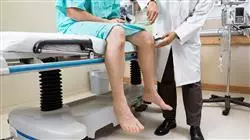University certificate
The world's largest faculty of nursing”
Introduction to the Program
You will learn about the specific care that neurological patients require, and recognize the most common complications, a vitally important issue for patients"

Neurological diseases have a broad impact on society. These diseases affect the entire population, regardless of age. Its consequences have a negative impact on the quality of life of the affected patients, preventing a high percentage of them from carrying out basic day-to-day activities, creating great dependence with the resulting cost, both in terms of healthcare and in terms of family and social care for the caregivers in charge of these patients (in Alzheimer's disease, 80% of the family members are cared for by relatives). They also have a major impact on mortality.
Stroke, for example, is the second leading cause of death globally and the first in women. Alzheimer’s disease, among other dementias, has a prevalence of between 4% and 9%, reaching 50% in people over 90 years of age. Parkinson’s disease, epilepsy, migraine, demyelinating and neuromuscular diseases also represent a serious social and health problem.
In addition, this Masters Degree will study the pathophysiology of the main neurological diseases from a nursing approach. Having nurses who are highly qualified in the management of patients with different neurological pathologies increases the quality of care and reduces complications. Knowing the specific care required by neurological patients and knowing how to recognize the most common complications is of paramount importance in these patients, as it will allow them to recover their autonomy as much as possible. In this regard, there are several scientific articles that show that having nurses who are experts in advanced practices such as sclerosis, movement disorders or headaches and migraines, provides significant benefits. It highlights the adherence to treatment and increased independence, which promotes patients’ return to work and other daily activities.
This online Masters Degree is made up of 10 modules and more than 100 units designed by a group of nursing professionals with extensive experience in healthcare and teaching, who carry out their work in a highly complex hospital setting.
Having highly qualified nursing staff increases the quality of care and reduces complications"
This Masters Degree in Neurology Nursing contains the most complete and up-to-date scientific program on the market. The most important features include:
- More than 100 practical case studies presented by experts in neurological nursing
- Graphic, schematic and practical contents, which are designed to provide essential scientific and assistance information for professional practice
- Latest developments in neurological nursing
- Practical exercises
- Theoretical lessons, questions to the experts and clinical cases for individual reflection
- Content that is accessible from any fixed or portable device with an Internet connection
It has been proven that having nurses with expertise in advanced practice such as sclerosis, movement disorders or headaches and migraines has significant benefits for the patient, including encouraging them to continue with treatment and gaining increased independence"
The program’s teaching staff includes professionals from the sector who contribute their work experience to this program, as well as renowned specialists from leading societies and prestigious universities.
The multimedia content, developed with the latest educational technology, will provide the professional with situated and contextual learning, i.e., a simulated environment that will provide immersive training programmed to learn in real situations.
This program is designed around Problem-Based Learning, whereby the professional must try to solve the different professional practice situations that arise throughout the program. For this purpose, the professional will be assisted by an innovative interactive video system created by renowned and experienced experts.
Deepen your nursing knowledge and specialize in neurology service care with TECH"

In this Masters Degree, you will learn to apply the pathophysiology of the main neurological diseases from a nursing approach"
Why study at TECH?
TECH is the world’s largest online university. With an impressive catalog of more than 14,000 university programs available in 11 languages, it is positioned as a leader in employability, with a 99% job placement rate. In addition, it relies on an enormous faculty of more than 6,000 professors of the highest international renown.

Study at the world's largest online university and guarantee your professional success. The future starts at TECH”
The world’s best online university according to FORBES
The prestigious Forbes magazine, specialized in business and finance, has highlighted TECH as “the world's best online university” This is what they have recently stated in an article in their digital edition in which they echo the success story of this institution, “thanks to the academic offer it provides, the selection of its teaching staff, and an innovative learning method aimed at educating the professionals of the future”
A revolutionary study method, a cutting-edge faculty and a practical focus: the key to TECH's success.
The most complete study plans on the university scene
TECH offers the most complete study plans on the university scene, with syllabuses that cover fundamental concepts and, at the same time, the main scientific advances in their specific scientific areas. In addition, these programs are continuously being updated to guarantee students the academic vanguard and the most in-demand professional skills. In this way, the university's qualifications provide its graduates with a significant advantage to propel their careers to success.
TECH offers the most comprehensive and intensive study plans on the current university scene.
A world-class teaching staff
TECH's teaching staff is made up of more than 6,000 professors with the highest international recognition. Professors, researchers and top executives of multinational companies, including Isaiah Covington, performance coach of the Boston Celtics; Magda Romanska, principal investigator at Harvard MetaLAB; Ignacio Wistumba, chairman of the department of translational molecular pathology at MD Anderson Cancer Center; and D.W. Pine, creative director of TIME magazine, among others.
Internationally renowned experts, specialized in different branches of Health, Technology, Communication and Business, form part of the TECH faculty.
A unique learning method
TECH is the first university to use Relearning in all its programs. It is the best online learning methodology, accredited with international teaching quality certifications, provided by prestigious educational agencies. In addition, this disruptive educational model is complemented with the “Case Method”, thereby setting up a unique online teaching strategy. Innovative teaching resources are also implemented, including detailed videos, infographics and interactive summaries.
TECH combines Relearning and the Case Method in all its university programs to guarantee excellent theoretical and practical learning, studying whenever and wherever you want.
The world's largest online university
TECH is the world’s largest online university. We are the largest educational institution, with the best and widest online educational catalog, one hundred percent online and covering the vast majority of areas of knowledge. We offer a large selection of our own degrees and accredited online undergraduate and postgraduate degrees. In total, more than 14,000 university degrees, in eleven different languages, make us the largest educational largest in the world.
TECH has the world's most extensive catalog of academic and official programs, available in more than 11 languages.
Google Premier Partner
The American technology giant has awarded TECH the Google Google Premier Partner badge. This award, which is only available to 3% of the world's companies, highlights the efficient, flexible and tailored experience that this university provides to students. The recognition as a Google Premier Partner not only accredits the maximum rigor, performance and investment in TECH's digital infrastructures, but also places this university as one of the world's leading technology companies.
Google has positioned TECH in the top 3% of the world's most important technology companies by awarding it its Google Premier Partner badge.
The official online university of the NBA
TECH is the official online university of the NBA. Thanks to our agreement with the biggest league in basketball, we offer our students exclusive university programs, as well as a wide variety of educational resources focused on the business of the league and other areas of the sports industry. Each program is made up of a uniquely designed syllabus and features exceptional guest hosts: professionals with a distinguished sports background who will offer their expertise on the most relevant topics.
TECH has been selected by the NBA, the world's top basketball league, as its official online university.
The top-rated university by its students
Students have positioned TECH as the world's top-rated university on the main review websites, with a highest rating of 4.9 out of 5, obtained from more than 1,000 reviews. These results consolidate TECH as the benchmark university institution at an international level, reflecting the excellence and positive impact of its educational model.” reflecting the excellence and positive impact of its educational model.”
TECH is the world’s top-rated university by its students.
Leaders in employability
TECH has managed to become the leading university in employability. 99% of its students obtain jobs in the academic field they have studied, within one year of completing any of the university's programs. A similar number achieve immediate career enhancement. All this thanks to a study methodology that bases its effectiveness on the acquisition of practical skills, which are absolutely necessary for professional development.
99% of TECH graduates find a job within a year of completing their studies.
Master's Degree in Nursing in the Neurology Service
The nursing area is a very relevant branch in the medical sector, since, thanks to their work, patients receive personalized and adequate care for each one, in addition, they are a support and an important pillar for the doctors' function. The constant renewal of knowledge for these professionals is a requirement for their career to increase in level and keep growing constantly. If you are a nurse and want to give a different approach to your career in order to acquire new skills, take a Master's Degree in Nursing in the Neurology Service at TECH - the best online university in the world. Specialize with the most advanced studies in the market in pathophysiology, medical-surgical care and training on methodologies aimed at neurological patients. Update your knowledge and learn first-hand about the latest treatments and care that a person with a related disease should receive.
Get certified with a Master's Degree focused on neurology
During 1,500 hours of fully online study you will specialize in the largest nursing faculty in the world. You will learn about specific care for patients with neurological diseases, which today are a large part of the population. At TECH Global University you will reinforce your knowledge in the specific care required by each patient; in addition, you will be a great support for people suffering from any pathology, because they will be able to be independent and resume their lifestyle without major complications. Additionally, you will have at your fingertips more than 100 topics designed by a team of high-level nursing specialists, as well as the theoretical and practical content presented through multimedia resources. Finally, you will participate in the clinical analysis of multiple cases, which will help you simulate possible situations in real cases. From this, you will be able to create standardized health plans and manage the criteria for activation of the Stroke Code.







